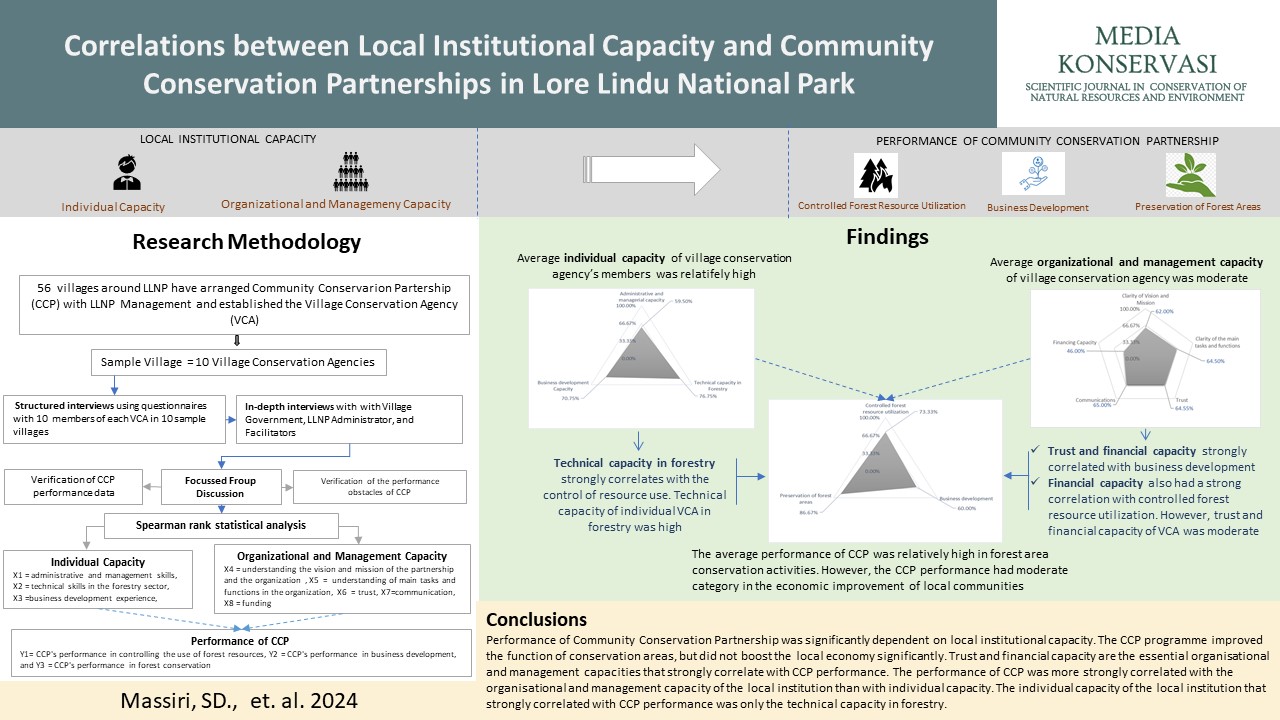To submit a manuscript to Media Konservasi, please download and fill the Author Statement Form here:
The form should be signed by hand by all of the authors, and should be submitted along with the manuscript in the submission stage.
Media Konservasi is scientific journal which publish article particularly conservation natural resource and environment. The Journal of Media Konservasi has been distributed to several libraries, forest and environment institutions in Indonesia. The media conservation published three series in every year.
The manuscript should be written in English language. The manuscript which is proposed must never be published in others media. Here writing guidance for the manuscript:
- Manuscript is a science writing based on the result of research, literature study, essay and book review.
- Manuscript or research article must be linked in tittle, writer identity, abstract, key word, introduction, research method, result and discussion, conclusion and a thank-you note, reference and appendix (if necessary).
- The tittle must be clear and maximum twelve (12) words in English Language.
- The writer identity includes the full name of writer (avoid using acronym) and put arabic number respectively for explanation about the writer (if more than one writer). Full address contains institution name, institution address and postal code, country of origin. For the correspondence writer shall put an email address which can be used to communicate quickly and easily.
- The Abstract in 250 words at most, arranged in one paragraph, written clearly, intact, and completely illustrates the essence of the contents of the entire writing not a summary of the writing. The abstract contains a resume of the background of the problem, research methods, results and discussion.
- The key words contain three to five words which reflects the concept that contained in the article and arranged alphabetical.
- Introduction (includes the reasons for doing research, problems, objectives, a little literature review, and hypotheses if any). The purpose of the study is stated explicitly and written in the last paragraph.
- The research methods are described in detail and clearly combined in one chapter title (consist of study location, materials and tools if any, research design, data collection techniques, data processing and analysis).
- Result and discussion are combined in one chapter. We recommend separate approach for results and discussion. In separated approach, you present the results first, providing an objective description of your findings, and then follow with a separate discussion section where you interpret and discuss the implications of those findings.
- Conclusions are the answer of the research objectives and do not contain a summary of the results. Conclusions are written in paragraph form and do not using bullet points.
- Pictures (photographs, diagrams, graphs, etc.) are presented in black and white. Color pictures will still print in black and white.
- Reference compiled with following CSE style of Harvard system. We recommend preparing the references with a bibliography software package, such as Mendeley, EndNote, ReferenceManager or Zotero. Examples of reference list:
- Journal Articles:
1. Author 1, A.B.; Author 2, C.D. Title of the article. Abbreviated Journal Name Year, Volume, page range. - Books and Book Chapters:
2. Author 1, A.; Author 2, B. Book Title, 3rd ed.; Publisher: Publisher Location, Country, Year; pp. 154–196.
3. Author 1, A.; Author 2, B. Title of the chapter. In Book Title, 2nd ed.; Editor 1, A., Editor 2, B., Eds.; Publisher: Publisher Location, Country, Year; Volume 3, pp. 154–196. - Unpublished materials intended for publication:
4. Author 1, A.B.; Author 2, C. Title of Unpublished Work (optional). Correspondence Affiliation, City, State, Country. year, status (manuscript in preparation; to be submitted).
5. Author 1, A.B.; Author 2, C. Title of Unpublished Work. Abbreviated Journal Name year, phrase indicating stage of publication (submitted; accepted; in press). - Unpublished materials not intended for publication:
6. Author 1, A.B. (Affiliation, City, State, Country); Author 2, C. (Affiliation, City, State, Country). Phase describing the material, year. (phase: Personal communication; Private communication; Unpublished work; etc.) - Conference Proceedings:
7. Author 1, A.B.; Author 2, C.D.; Author 3, E.F. Title of Presentation. In Title of the Collected Work (if available), Proceedings of the Name of the Conference, Location of Conference, Country, Date of Conference; Editor 1, Editor 2, Eds. (if available); Publisher: City, Country, Year (if available); Abstract Number (optional), Pagination (optional). - Thesis:
8. Author 1, A.B. Title of Thesis. Level of Thesis, Degree-Granting University, Location of University, Date of Completion. - Websites:
9. Title of Site. Available online: URL (accessed on Day Month Year).
Unlike published works, websites may change over time or disappear, so we encourage you create an archive of the cited website using a service such as WebCite. Archived websites should be cited using the link provided as follows:
10. Title of Site. URL (archived on Day Month Year).
- Journal Articles:
- Media Konservasi uses MDPI style for reference citation and list. Please download the style for Mendeley or Zotero here:
Mendeley: https://csl.mendeley.com/styleInfo/?styleId=http%3A%2F%2Fwww.zotero.org%2Fstyles%2Fremote-sensing
Zotero: https://www.zotero.org/styles/multidisciplinary-digital-publishing-institute - We also encourage author to provide a graphical abstract. This is a single-panel image serves to instantly convey the key message of your scientific paper. Please provide it in either PNG or JPG format, proportioned at 4:3. The graphical abstract will be displayed alongside manuscript galley on our website. Example of graphical abstract:

from: Kennedi et al. (2024)
from: Massiri et al. (2024)




1.png)